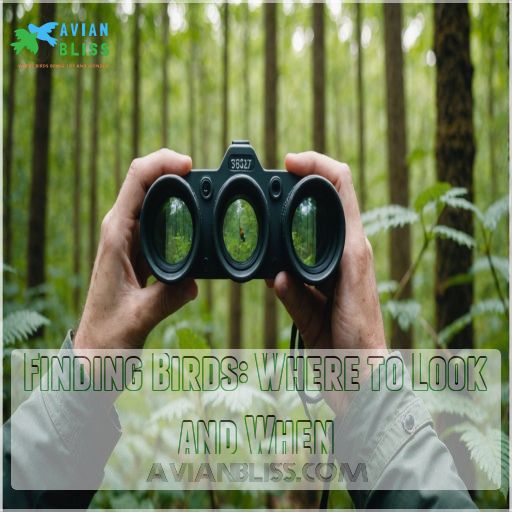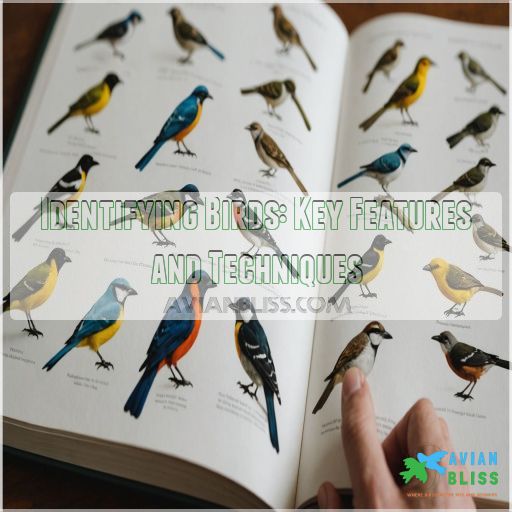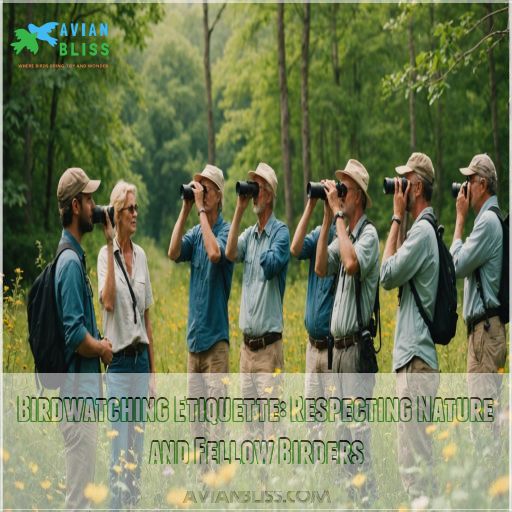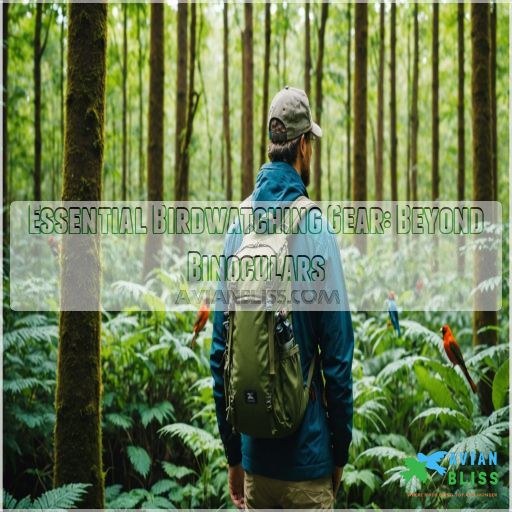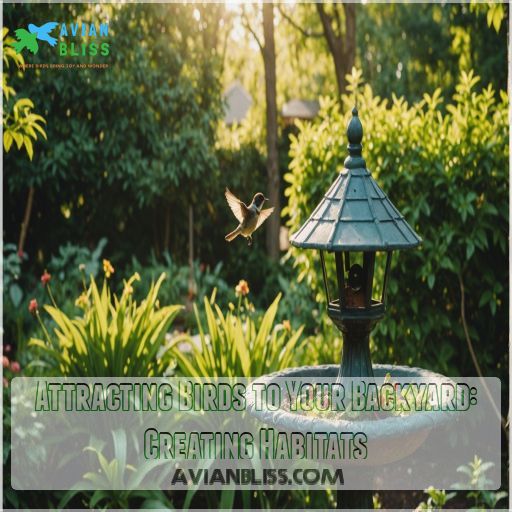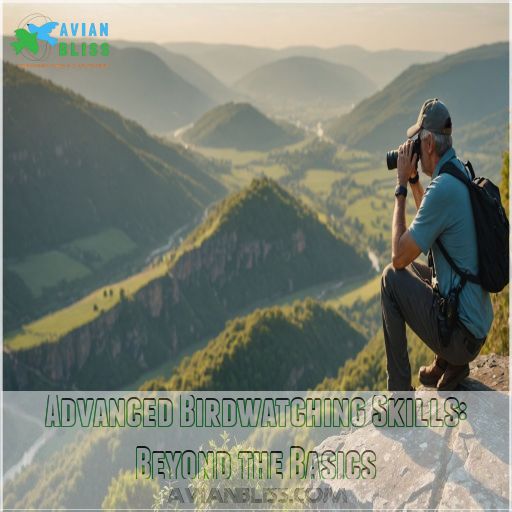This site is supported by our readers. We may earn a commission, at no cost to you, if you purchase through links.

This birdwatching guide will turn your morning strolls into fascinating explorations. Start with some essential gear—binoculars for that close-up magic, a field notebook for jotting quirky bird antics, and a nifty birding app like Merlin Bird ID.
Keep your eyes peeled at sunrise or dusk, when the avian crowd gets chatty. Remember, birdwatching is about patience and the joy of spotting a feathered friend during optimal weather conditions, ideal birdwatching times
.
Embrace the journey, enjoy the sights, and prepare for some delightful surprises in the wild. Curious for more tips? Read on for a more fascinating exploration.
Table Of Contents
- Key Takeaways
- Getting Started With Birdwatching: a Beginner’s Guide
- Finding Birds: Where to Look and When
- Identifying Birds: Key Features and Techniques
- Birdwatching Etiquette: Respecting Nature and Fellow Birders
- Essential Birdwatching Gear: Beyond Binoculars
- Attracting Birds to Your Backyard: Creating Habitats
- Advanced Birdwatching Skills: Beyond the Basics
- Frequently Asked Questions (FAQs)
- How do I choose the right bird guide?
- How do I get the most out of birdwatching?
- How do I find a good place to bird watch?
- How do I find a bird guide?
- How do I distinguish similar gull species?
- What is the best cold-weather birdwatching strategy?
- How do I choose a birding location?
- How can birdwatching improve mental well-being?
- What are the benefits of organized birding tours?
- Conclusion
Key Takeaways
- Gear up for your birdwatching adventures with essential tools like binoculars, field guides, and handy birding apps – they will turn your morning strolls into fascinating explorations.
- Embrace the journey and enjoy the sights, whether you are spotting common backyard birds or rare feathered gems. Patience and an open mind are the keys to delightful surprises in the wild.
- Discover the best times and places to find your feathered friends, from bustling cityscapes to tranquil nature havens. Timing and habitat knowledge are your secret weapons for a successful birdwatching adventure.
- Take your skills to the next level by mastering bird identification techniques, understanding migration patterns, and contributing to citizen science projects; you will become a true feathered paparazzi in no time.
Getting Started With Birdwatching: a Beginner’s Guide
Want to discover the wonders of birdwatching but don’t know where to start?
This beginner’s guide will equip you with essential tips on gear, field guides, and birding apps, setting you up for success as you begin your feathered adventures.
Essential Gear for Novice Birdwatchers
Ready to start your birdwatching journey? Let’s gear up!
First things first: you’ll need a trusty pair of binoculars. They’re your window into the avian world, bringing distant birds up close. Don’t worry about breaking the bank – there are quality options for every budget.
Grab a notebook to jot down your sightings, and download some handy birding apps like Merlin Bird ID .
Comfortable clothing and footwear are essential for those long nature walks.
Choosing the Right Field Guide
Picking the right field guide is like finding a perfect pair of binoculars – you want one that’s just right for your birdwatching adventures. The Sibley Guide to Birds is a great choice for beginners, offering clear illustrations and thorough coverage.
- Detailed illustrations or photographs
- Range maps for each species
- Information on bird calls and behaviors
- Compact size for field use
- Durable, weather-resistant construction
Downloading Useful Birding Apps
Now that you’ve got your field guide, it’s time to supercharge your birding with some handy apps. These digital assistants can turn your phone into a pocket-sized ornithologist.
From Merlin’s beginner-friendly bird ID wizard to eBird’s global sighting database, there’s an app for every level of birder.
Don’t forget to check out BirdsEye for local hotspots and Audubon for its extensive sound library. Just remember, your phone’s a tool, not a crutch!
Setting Realistic Expectations for Your First Outings
Your first birdwatching outing mightn’t be as action-packed as those nature documentaries, but that’s okay!
Set yourself up for success with these realistic expectations:
- Limited sightings: You may only spot a few common species
- Patience required: Birds don’t appear on command
- Learning curve: Identifying birds takes practice
- Enjoyment matters: Focus on the experience, not the numbers
Remember, every experienced birder started as a novice. Embrace the journey and let your inner bird nerd take flight!
Finding Birds: Where to Look and When
You’ve got your binoculars and field guide ready, but where are all those elusive birds hiding?
Don’t worry – we’ll show you the best spots and times to find feathered friends.
From your backyard to bustling cityscapes and beyond.
Best Times of Day for Birdwatching
Grabbing your binoculars at sunrise can be like unwrapping a gift—birds are most active during the "golden hour". Midday, they nap like teenagers after a big meal. Dusk brings a symphony of songs as they settle down, and don’t dismiss night; owls hoot in the dark.
Timing can transform your birdwatching adventure into a real-life safari.
| Time of Day | Bird Activity | Example Birds |
|---|---|---|
| Sunrise | High activity, feeding and singing | Warblers, thrushes |
| Golden Hour | Best light and visibility | Sparrows, robins |
| Midday | Quiet, resting birds | Hawks, eagles |
| Dusk | Pre-roost rituals and calls | Starlings, cardinals |
| Night | Nocturnal hunting and calls | Owls, nightjars |
Seasonal Patterns in Bird Activity
It’s birdwatching bingo as the seasons change! Embrace the magic of bird migration and alterations in activity.
- Spring arrival brings nesting and vibrant singing.
- Fall migration dazzles with diverse species passing through.
- Winter feeding attracts hearty flocks braving the cold.
- Breeding season showcases lively courtship displays.
Join birdwatching communities to share these thrilling experiences!
Urban Birdwatching Opportunities
Birdwatching goldmine! Picture urban bird feeders bustling with city parks’ vibrant charm, near native New York vegetation, like thistle plants found
. Arm yourself with bird-watching binoculars and a trusty bird book to navigate these urban jungles. Find common species exploring backyard birds as you identify them with ease, learning about California’s diverse bird populations attracting backyard birds of California
.
Embrace urban birdwatching by visiting these ideal spots:
| Spot | Birds to See |
|---|---|
| Central Park | Warblers |
| Prospect Park | Red-tailed Hawks |
| Jamaica Bay | Shorebirds |
Enjoy your feathered friends!
Exploring Diverse Habitats for Varied Species
Switching to more tranquil scenes, explore diverse habitats to spot varied bird species, like the forests, parks, and even urban areas small birds in Virginia can be found that are home to a variety of small bird species
.
Keep an eye on:
- Dense Forests: Home to secretive owls.
- Wetlands: Teeming with migratory ducks.
- Coastal Areas: Vagrants get lost here.
- Open Fields: Sparrows and raptors abound.
Join a birding club and remember: ethics and conservation make birdwatching a joy.
Identifying Birds: Key Features and Techniques
Spotting rare birds like a pro requires keen observation skills.
Where a bird’s unique colors, calls, and quirky behaviors become your best clues.
Don’t worry if you can’t tell a Blue Jay from a cardinal yet—practice makes perfect, and soon you’ll be their feathered paparazzi!
Understanding Bird Anatomy and Plumage
To spot rare birds like a pro, understanding their anatomy and plumage is key.
Pay attention to bird beak types, feather types, color patterns, and wing shapes. Notice how molt cycles change a bird’s look, much like how you outgrew those outdated jeans.
Recognize these traits for successful birdwatching! It’s like learning a secret handshake in nature. (Source)
Recognizing Common Bird Calls and Songs
Recognizing the unique calls and songs of birds is a game-changer for your birdwatching adventures.
Use apps like Merlin Sound ID to instantly identify the feathered vocalists around you.
Plus, listening to recordings and using mnemonics can help those melodies stick in your mind. It’s like learning a secret language of the birds!
Using Size and Shape for Quick Identification
Imagine this: you’re mastering bird calls and now tackle size and shape to figure out new IDs.
Compare birds using well-known species like robins or crows—like using familiar landmarks in a new city.
Silhouette identification and wingspan clues reveal hidden gems; remember, a finch always looks like a finch despite varying colors.
Observing Behavior Patterns for Species Clues
Every bird tells its story through behavior. Watch how it feeds—some birds dine mid-air, others peck the ground.
Notice flight patterns: a swallow’s swift darting versus a hawk’s soaring glide.
Observe nesting habits and social interactions. Even how they respond to predators reveals secrets.
It’s like learning a new language—bird symphony! Time and keen eyes are your best tools.
Birdwatching Etiquette: Respecting Nature and Fellow Birders
When you’re out birdwatching, keeping nature undisturbed and respecting fellow birders can make the experience much more enjoyable for everyone.
Remember, shouting out a bird’s location won’t help you earn a "most popular birder" badge, and respecting others is key to enjoying the activity of birdwatching.
Minimizing Disturbance to Birds and Habitats
You’ve got the bird’s-eye view on identification, now let’s chat about minimizing disturbance in their habitats.
Ensuring your birdwatching ethics are up to snuff means being a responsible birder and focusing on wildlife safety.
- Keep a respectful distance.
- Avoid roaming near nesting areas.
- Stick to marked trails.
- Leash your furry friends.
Enjoy nature without ruffling feathers!
Proper Use of Bird Calls and Recordings
Respect for nature means letting birds sing without interference.
When using recordings, keep ethical considerations in mind.
Playback etiquette suggests low volume and brief clips to avoid distressing birds or misleading them into thinking there’s a rival.
Remember, birds are savvy.
Often, they just ignore your attempts completely—so don’t feel bad if they don’t engage, which is an important part of playback etiquette.
Sharing Observations Without Overcrowding Locations
While using bird calls responsibly is key, sharing your amazing discoveries with fellow birders means keeping birdwatching spots serene.
To do this, remember:
- Limit social media details about specific locations.
- Use general names instead of exact spots.
- Encourage a small group of enthusiasts.
- Promote ethical birding practices and respect nature’s balance by following birding etiquette guidelines
.
Happy birdwatching!
Contributing to Citizen Science Projects
Joining citizen science projects is a fantastic way to contribute to bird conservation efforts while honing your birding skills.
Projects like eBird, the Great Backyard Bird Count, and NestWatch allow you to submit valuable data that informs research and guides conservation strategies . Plus, you’ll connect with a community of fellow bird enthusiasts.
Check out the table below to find the right project for you:
| Project | Focus | Commitment |
|---|---|---|
| eBird | Year-round bird sightings | Ongoing |
| Great Backyard Bird Count | 4-day annual event | 15 minutes per day |
| NestWatch | Monitoring bird nests | Periodic nest checks |
| Project FeederWatch | Winter bird feeding | November to April |
Essential Birdwatching Gear: Beyond Binoculars
When you’re out to spot those elusive birds, you’ll need more than just binoculars.
Equip yourself with a trusty field notebook.
Wear the right clothes for the adventure.
Maybe snap a birdie selfie with a good camera!
Selecting the Right Binoculars for Your Needs
Spotting rare birds requires more than a keen eye; a trusty pair of binoculars is your secret weapon.
Consider binocular magnification, budget considerations, and comfort.
An 8×42 pair balances power and weight perfectly.
Make sure they offer a wide field of view and good lens quality.
Remember, even birders need their trusty sidekicks!
Importance of a Good Field Notebook
Picking binoculars was a hoot, but don’t forget your field notebook.
It’s your birdwatching BFF, helping you capture detailed records of bird sightings and behavior down the line.
With each scribble, you’re tracking observations and creating a birdscape memoir.
Plus, sketches—even stick figures—won’t judge!
Your field journal is a treasure chest of avian wonders (Source).
Appropriate Clothing for Different Birding Environments
Dress for success and blend in with nature by wearing camouflage and layers.
Weather can change faster than a chickadee in flight, so be prepared.
Sturdy footwear keeps you steady, whether traipsing through a dry forest or a marshland.
Accessories like hats and gloves come in handy, so don’t overlook them; snug gear makes you comfortable and stealthy in any environment.
Photography Equipment for Bird Documentation
Capturing birds in their natural habitat is thrilling, so you’ll want the right gear.
Start with a camera featuring excellent image stabilization and versatile lenses.
Tweak your camera settings to match light conditions for sharper shots.
Editing software is your friend for perfecting those memorable images.
Remember, even pro photographers began with shaky first steps!
Attracting Birds to Your Backyard: Creating Habitats
Want more birds in your backyard?
Set out some tasty snacks, cozy shelter, and a splash of water, and you’ll transform your yard into a bird paradise faster than a pigeon at a picnic!
Selecting and Maintaining Bird Feeders
Choosing the right bird feeders is like finding the perfect fit – you want something sturdy, squirrel-proof, and easy to maintain.
Start with a classic tube feeder or platform tray, and experiment with different seed types to attract a diverse array of feathered friends.
Just be sure to clean feeders regularly to keep your backyard birds happy and healthy.
Planting Native Species for Food and Shelter
Ever wonder how to transform your yard into a bird’s paradise?
Start by planting native species like oaks or dogwoods that cater to local birds’ needs, as found in common Indiana backyard birds Indiana bird habitats
.
These plants offer food and shelter, boosting backyard biodiversity and attracting pollinators.
Remember, even small changes, like replacing a single plant, can make a big impact and become a feathered friend favorite.
Providing Water Sources for Birds
Adding water to your backyard is like rolling out the red carpet for feathered guests. Position bird baths wisely to make sure safety and comfort.
Here’s how to create a welcoming space for birds:
- Keep water clean with vinegar.
- Opt for shady, open spots.
- Try ceramic bird baths.
- Rotate water sources weekly.
- Create easy perching spaces nearby.
Birds will thank you with joyful visits! .
Creating Safe Spaces From Predators
After providing water, let’s make your backyard a fortress for your feathered friends.
Use predator-proof feeders and cat deterrents for peace of mind. Secure nest boxes and be aware of hawks overhead.
imagine birds having secret chat rooms, gossiping about your safe haven!
| Problem | Solution | Benefit |
|---|---|---|
| Cats | Deterrents | More birds |
| Hawks | Awareness | Safe nesting |
| Nighttime | Security | Peace of mind |
| Aging Boxes | Repairs | Long-term haven |
| Spoiled Feed | Cleaners | Healthier birds |
Advanced Birdwatching Skills: Beyond the Basics
Ready to take your birdwatching skills up a notch?
Learn to navigate migration patterns and spot subspecies with ease, so you won’t mistake a rare bird for a common pigeon!
Understanding Bird Migration Patterns
Get a closer look at the fascinating world of bird migration by exploring four key elements.
- Migration Routes: Birds often follow the Atlantic, Mississippi, Central, and Pacific Flyways.
- Timing: Seasons dictate when birds start their epic journeys.
- Factors and Challenges: Weather, predators, and food scarcity play significant roles.
- Conservation: Protect stopover habitats to aid these feathered travelers.
Recognizing Subspecies and Regional Variations
You’re on a migration marathon, tracking subspecies and regional variations adds a twist.
Ever spotted a Dark-eyed Junco‘s plumage differences across regions? It’s like comparing apples to oranges!
| Subspecies | Location | Plumage | Habitat | Notes |
|---|---|---|---|---|
| Slate-colored | East | Gray | Forests | Common |
| Oregon | West | Hooded | Mixed | Distinctive |
Spotting these quirks makes birding a richer adventure!
Techniques for Birdwatching in Challenging Environments
Birdwatching in challenging environments like dense foliage or noisy urban areas requires patience and keen observation.
Start by moving slowly and quietly, scanning for subtle movements and listening intently for bird calls.
Use your binoculars to scan the canopy. Focus on identifying birds by their silhouettes and behavior, using distinctive flight patterns such as wing shapes like a flying cigar
.
Stay alert for flocks that may reveal hidden species .
Using Technology for Precise Bird Tracking
Technology opens up a world of possibilities for tracking birds. Apps with GPS tracking and AI bird identification, like Merlin and Audubon, make it easy to spot rare species. Pair these with citizen science data from eBird, and you’ve got a winning combo.
Consider using drones for bird surveys too.
Look at the table below:
| Tool | Function |
|---|---|
| Bird Tracking Apps | Identify and locate birds |
| GPS | Track real-time locations |
| AI | Identify species |
| Citizen Science Data | Contribute to research |
| Drones | Survey difficult areas |
Frequently Asked Questions (FAQs)
How do I choose the right bird guide?
Choosing the right bird guide is like picking a travel buddy for the wild: consider whether you prefer photos or drawings, or if you’d rather have a slim guide like Kaufman to start or an **app for high-tech aid.
How do I get the most out of birdwatching?
Start by exploring diverse habitats at dawn when birds are most active.
A good pair of binoculars and a birding app like Merlin can enhance your experience.
Stay curious, enjoy the moments, and embrace the surprises.
How do I find a good place to bird watch?
Explore nearby parks, nature reserves, and wildlife refuges; they’re often birdwatching goldmines.
Apps like eBird help pinpoint hotspots by bird species count.
Also, consider favorite local spots like Montrose Point or Jones Beach .
How do I find a bird guide?
Boost your birding skills by tapping into the wealth of local expertise.
Just spread your wings and let the friendly flock of fellow birders guide you.
To the hidden avian gems in your area. (Source)
How do I distinguish similar gull species?
To tell gull species apart, focus on size, shape, and color.
Check leg and bill colors, wing patterns, and back shades.
Even subtle differences can reveal species.
Practice makes perfect, and soon you’ll master the art.
What is the best cold-weather birdwatching strategy?
Warm up with backyard birdwatching by setting up feeders filled with high-fat foods.
A heated water source—birds will flock to your yard like it’s the hottest spot in town!
You’re nature’s host with the most.
How do I choose a birding location?
Pick a birding location that fits your goals and energy level.
Opt for local parks or eBird hotspots if you want to see lots of birds.
Use your phone’s GPS to help find or share locations.
How can birdwatching improve mental well-being?
Immerse yourself in birdwatching, and watch worries take flight!
The calming rhythm of nature enhances mood, reduces loneliness, and sharpens focus while spotting the sneaky woodpecker.
Who knew mindfulness came with feathers?
What are the benefits of organized birding tours?
Joining an organized birding tour lets you share costs and expertise, while local guides help you quickly find rare species.
Gather with fellow enthusiasts in a hassle-free adventure where every bird sighting feels like a jackpot!
Conclusion
Think of birdwatching as a treasure hunt with nature’s gems.
With these expert tips, your birdwatching guide transforms strolls into grand adventures, offering glimpses of rare, winged wonders.
Armed with the right gear and a sharp eye, you’ll master spotting timelines, habitats, and behaviors.
Whether in bustling cities or tranquil woods, each outing writes a new story.
So, grab your binocs, hit the trails, and enjoy chasing feathers—because every sighting holds a delightful surprise!


